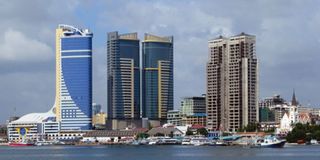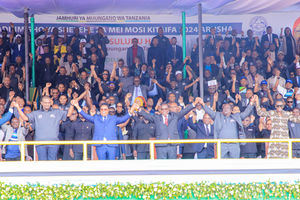Prime
Tanzania’s per capita income increases by five percent

A section of Tanzania's commercial capital Dar es Salaam
What you need to know:
- According to the BoT’s report on zonal economic efficiency, per capita income increased from Sh2.70 million in 2022 to Sh2.84 million.
Dar es Salaam. New Bank of Tanzania (BoT) statistics show that per capita income in Tanzania rose by five percent over the past year, driven by swift economic growth in Dar es Salaam and the Lake and Northern zones.
According to the BoT’s report on zonal economic efficiency, per capita income increased from Sh2.70 million in 2022 to Sh2.84 million.
Released on October 5, the report shows that the average income of Dar es Salaam residents rose more than other parts of the country, from Sh4.81 to Sh5.39 million in 2022.
This is equivalent to 12 percent growth compared to the previous year, when per capita income in Dar es Salaam increased by Sh500,000.
Individual income calculations are derived by dividing the national income (GDP) or a certain area by the population residing there.
According to the International Monetary Fund (IMF), GDP is measured by looking at the value of goods and services produced in the specified period, and not all are included in the calculation.
Activities not included in the calculation are those for which a person is not paid (volunteer work) and illegal or informal businesses, which are difficult to measure their values.
In terms of the highest income per capita, Dar es Salaam is followed by the Northern Zone, where BoT statistics show an annual average income of Sh3.38 million, increasing by 8.4 percent compared to that of 2021.
The Northern Zone is followed by the Southern Highlands Zone, where residents’ annual average income is Sh3.10 million, and taking third position is the Southeastern Zone, where annual per capita income is Sh2.7 million.
The Lake Zone recorded significant economic growth in 2022, with the average income of its residents increasing by 10.6 percent to Sh2.27 million, up from Sh2.05 million in 2021.
The report shows that despite overall growth, two out of the six zones experienced negative growth in their per capita income. The per capita of the Southeastern Zone decreased by 6.5 percent, while that of the Central Zone slumped by 2.7 percent.
“All zones had per capita growth except for the central and southeastern zones. This situation is largely due to a significant increase in the population in those areas. Dar es Salaam and the Northern and Southern Highlands zones had per capita that surpassed the national standards,” says the report.
Regarding the trend, Dr Lutengano Mwinuka, a lecturer in the faculty of Economics at the University of Dodoma (Udom), says that the positive and negative economic growth of the relevant zone is a result of the types of economic activities being carried out there.
“Zones with low or negative growth in per capita income means that their economic activities have declined or have experienced slow growth of their economic activities amid the population increase,” he said.
Dr Mwinuka added that increased economic growth in slow-growing regions, proper land use and more investment in industries that add value to locally produced goods and crops are essential.
In terms of the contribution of each zone to the national income, the Lake Zone contributes more than a quarter of the country’s total income (25.9 percent, equivalent to Sh44.18 trillion), followed by the Northern Zone at 17.2 percent (Sh29.29 trillion), and then Dar es Salaam at 17.1 percent (Sh29.02 trillion).
The Southern Highlands Zone contributes 15.8 percent (Sh26.92 trillion) to the total national income, the Central Zone at 13.5 percent (Sh22.92 trillion), while the Southeastern Zone contributing 10.5 percent (Sh17.89 trillion).
The report in general shows that growth in the national income has increased from Sh156.37 trillion to Sh170.25 trillion, with the increase mainly being attributed to the sectors of agriculture, construction, mining, industry, and trade.





